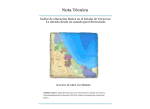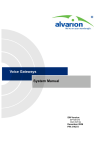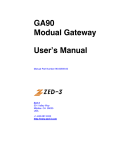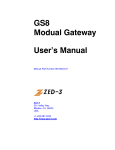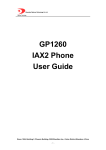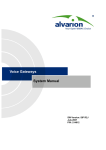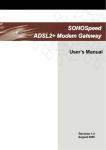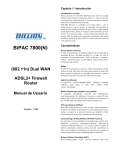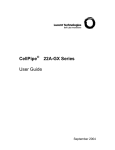Download AH4021 User's Manual - MGCP
Transcript
TECOM AH4021 User’s Manual - MGCP Version - Copyright © 2004 by TECOM CO., LTD. Table of Contents 1 INTRODUCTION ..................................................................................................................................................... 4 2 INSTALLATION ....................................................................................................................................................... 5 3 CONFIGURATION .................................................................................................................................................. 9 3.1 SETUP ............................................................................................................................................................... 9 3.2 ESTABLISH THE CONNECTION .......................................................................................................................... 9 3.3 QUICK SETUP ................................................................................................................................................. 11 3.3.1 PPP over Ethernet (PPPoE) Configuration.............................................................................................. 11 3.3.1.1 3.3.1.2 3.3.1.3 3.3.1.4 3.3.1.5 3.3.1.6 3.3.1.7 3.3.2 IP over ATM (IPoA) Configuration........................................................................................................... 16 3.3.2.1 3.3.2.2 3.3.2.3 3.3.2.4 3.3.2.5 3.3.2.6 3.3.2.7 3.3.3 ATM PVC and QoS Configuration ...................................................................................................................18 Connection Type ...............................................................................................................................................18 DHCP Client and WAN Service .......................................................................................................................19 Device Setup .....................................................................................................................................................20 Wireless – Setup ...............................................................................................................................................20 WAN Setup – Summery....................................................................................................................................20 MAC Encapsulation Routing (MER) Configuration ................................................................................. 21 3.3.4.1 3.3.4.2 3.3.4.3 3.3.4.4 3.3.4.5 3.3.4.6 3.3.4.7 3.3.5 ATM PVC and QoS Configuration ...................................................................................................................16 Connection Type ...............................................................................................................................................16 WAN IP Settings ...............................................................................................................................................16 NAT, Firewall, IGMP Multicast and WAN service ...........................................................................................17 Device Setup .....................................................................................................................................................18 Wireless – Setup ...............................................................................................................................................18 WAN Setup – Summary....................................................................................................................................18 Bridge Configuration ................................................................................................................................ 18 3.3.3.1 3.3.3.2 3.3.3.3 3.3.3.4 3.3.3.5 3.3.3.6 3.3.4 ATM PVC and QoS Configuration ................................................................................................................... 11 Connection Type and Encapsulation Mode.......................................................................................................12 PPP Username and Password............................................................................................................................12 IGMP Multicast and WAN service ...................................................................................................................13 Device Setup .....................................................................................................................................................14 Wireless – Setup ...............................................................................................................................................14 WAN Setup – Summery....................................................................................................................................15 ATM PVC and QoS Configuration ...................................................................................................................21 Connection Type ...............................................................................................................................................21 WAN IP Settings ...............................................................................................................................................22 NAT, IGMP Multicast and WAN service ..........................................................................................................23 Device Setup .....................................................................................................................................................23 Wireless – Setup ...............................................................................................................................................23 WAN Setup – Summery....................................................................................................................................23 PPP over ATM (PPPoA) Configuration ................................................................................................... 24 3.3.5.1 3.3.5.2 3.3.5.3 3.3.5.4 3.3.5.5 3.3.5.6 3.3.5.7 ATM PVC Configuration ..................................................................................................................................24 Connection Type ...............................................................................................................................................24 PPP Username and Password............................................................................................................................25 IGMP Multicast and WAN service ...................................................................................................................26 Device Setup .....................................................................................................................................................26 Wireless – Setup ...............................................................................................................................................26 WAN Setup – Summery....................................................................................................................................26 3.4 ADVANCED SETUP .......................................................................................................................................... 26 3.4.1 WAN .......................................................................................................................................................... 27 3.4.2 LAN ........................................................................................................................................................... 28 3.4.3 NAT ........................................................................................................................................................... 28 3.4.3.1 3.4.3.2 3.4.3.3 3.4.4 Security ..................................................................................................................................................... 32 3.4.4.1 3.4.4.2 3.4.5 3.4.6 Virtual Servers Setup ........................................................................................................................................28 Port Triggering Setup........................................................................................................................................30 DMZ Host.........................................................................................................................................................31 IP Filtering ........................................................................................................................................................32 Parental Control ................................................................................................................................................35 Quality of Service...................................................................................................................................... 36 Routing ...................................................................................................................................................... 38 3.4.6.1 3.4.6.2 Routing – Default Gateway ..............................................................................................................................38 Routing – Static Route ......................................................................................................................................38 Page 2 of 69 3.4.6.3 3.4.7 3.4.7.1 3.4.7.2 3.4.8 3.4.9 3.5 3.5.1 3.5.2 3.5.3 3.5.4 3.5.5 3.5.6 3.6 3.7 3.8 3.8.1 4 Backup ..............................................................................................................................................................58 Update ..............................................................................................................................................................58 Restore Default .................................................................................................................................................59 System Log ................................................................................................................................................ 60 SNMP Agent .............................................................................................................................................. 61 Internet Time ............................................................................................................................................. 62 Access Control .......................................................................................................................................... 63 3.8.5.1 3.8.5.2 3.8.5.3 3.8.6 3.8.7 DNS Server .......................................................................................................................................................40 Dynamic DNS ..................................................................................................................................................41 DSL ........................................................................................................................................................... 43 Port Mapping ............................................................................................................................................ 44 WIRELESS ....................................................................................................................................................... 47 Basic ......................................................................................................................................................... 47 Security ..................................................................................................................................................... 47 MAC Filter ................................................................................................................................................ 50 Wireless Bridge ......................................................................................................................................... 52 Advanced................................................................................................................................................... 52 Station Info ................................................................................................................................................ 55 VOICE ............................................................................................................................................................. 55 DIAGNOSTICS ................................................................................................................................................. 57 MANAGEMENT ............................................................................................................................................... 57 Settings ...................................................................................................................................................... 57 3.8.1.1 3.8.1.2 3.8.1.3 3.8.2 3.8.3 3.8.4 3.8.5 Routing – RIP ...................................................................................................................................................40 DNS ........................................................................................................................................................... 40 Services ............................................................................................................................................................63 IP Addresses .....................................................................................................................................................63 Passwords .........................................................................................................................................................64 Update Software........................................................................................................................................ 65 Save/Reboot .............................................................................................................................................. 65 APPENDIX .............................................................................................................................................................. 67 Page 3 of 69 1 Introduction Congratulations on becoming the owner of the AH4021. Your LAN (local area network) will now be able to access the Internet using your high-speed ADSL connection. This User Guide will show you how to install and set up your AH4021. Features Internal ADSL modem for high speed internet access 10/100Base-T Ethernet/USB router to provide Internet connectivity to all computers on your LAN Support for MGCP protocol 802.11b/g WLAN supported Network configuration through DHCP Configuration program you access via an HTML browser System Requirements In order to use your AH4021 router, you must have the following: ADSL service up and running on your telephone line, with at least one public Internet address for your LAN One or more computers each containing an USB, Ethernet 10BaseT/100Base-T network interface card or 802.11b/g WLAN card/adapter For system configuration using the supplied web-based program: a web browser such as Internet Explorer v5.0 or later, or Netscape v4.7 or later Page 4 of 69 Commentaire [CT1]: The document is written with the assumption that an ISP has provided the product to an existing customer. However, the text uses the phrase “your ISP” when referring the customer to his ISP for assistance, and when referring to preconfiguration the ISP has presumably performed. Search for instances of “ISP” and substitute the ISP’s actual name, or rewrite as needed. 2 Installation In addition to this document, your AH4021 should arrive with the following: One AH4021 One power adapter and power cord One cross-over/straight Ethernet cable Three RJ-11 to RJ-11 telephone Cable One splitter or low-pass filter Front Panel The front panel contains several LEDs that indicate the status of the unit. PWR DSL LAN1 TEL1 VoIP ALM WLAN LAN2 TEL2 USB Label Color Function PWR Green On: Unit is powered on Off: Unit is powered off ALM Yellow On: Major alarm occurs. Off: Unit is functioning well. DSL green Flashes during the training mode. On: ADSL link is established and active WLAN Green On: Wireless LAN is active Off: No wireless card or wireless LAN isn’t active Flashes during data transfer LAN1-2 Green On: LAN link established and active Off: No LAN link Flashes during data transfer TEL1-2 Green On: The telephone is off-hook Off: The telephone is on-hook VoIP Green On: VoIP link is established and active Off: VoIP link isn’t established and active USB Green On: USB link is established and active Off: No USB link Flashes during data transfer Page 5 of 69 Rear Panel The rear panel contains the ports for the unit's data and power connections. Label Function DSL RJ-11 connector: Connects the device to a telephone jack or splitter using the supplied cable USB USB connector: Connects the device to your PC's USB port, or to your USB hub, using the cable provided LAN1-2 RJ-45 connector: Connects the device to your PC's Ethernet port, or to the uplink port on your LAN's hub, using the cable provided TEL1-2 RJ-11 connector: Connects the device to your analog phones, using the cable provided RESET Return the configuration to factory default Power Connects to the supplied power converter cable On/Off Switches the device on and off Connecting the Hardware You connect the device to the phone jack, the power outlet, and your computer or network. WARNING Before you begin, turn the power off for all devices. These include your computer(s), your LAN hub/switch (if applicable), and the AH4021. Figure 1 illustrates the hardware connections. The layout of the ports on your device may vary from the layout shown. Refer to the steps that follow for specific instructions. Page 6 of 69 Figure 1. Overview of Hardware Connections Commentaire [CT2]: Edit picture to match your board’s connectors. Step 1. Connect the ADSL cable and optional telephone. Connect one end of the provided phone cable to the port labeled ADSL on the rear panel of the device. Connect the other end to your wall phone jack. You can attach a telephone line to the device. This is helpful when the ADSL line uses the only convenient wall phone jack. If desired, connect the telephone cable to the port labeled PHONE. WARNING Commentaire [CT3]: This warning assumes that the board contains an internal filter on the POTS line. If an external filter is used instead, document that step here and remove this warning (with an external filter, the ADSL and PHONE ports are interchangeable). Although you use the same type of cable, The ADSL and PHONE ports are not interchangeable. Do not route the ADSL connection through the PHONE port. Step 2. Connect the Ethernet cable. If you are connecting a LAN to the AH4021, attach one end of a provided Ethernet cable to a regular hub port and the other to the Ethernet port on the AH4021. Page 7 of 69 Step 3. Attach the power connector. Connect the AC power adapter to the PWR connector on the back of the device and plug in the adapter to a wall outlet or power strip. Step 4. Turn on the AH4021 and power up your systems. Press the Power switch on the back panel of the device to the ON position. Turn on and boot up your computer(s) and any LAN devices such as hubs or switches. Step 5. Configure the AH4021 through the WEB interface The detail step3 would be described in Chapter3. It would help you configure the AH4021 to meet your need. Step 6. Save the configurations and Reboot. To make the settings you made on AH4021 take effect. Page 8 of 69 3 Configuration 3.1 Setup Step 1: Connect the AH4021 and PC with a straight Ethernet cable. Step 2: Power on the AH4021. Step 3: The default IP of the AH4021 is 192.168.1.1. 3.2 Establish The Connection Enter the IP address (default is 192.168.1.1) of AH4021 from the Web Browser. A Dialogue Box will be popped up to request the user to login. (Figure 2) Figure 2. Authentication Please enter the management username/password into the fields then click on the OK button (default username/password is admin/admin). If the authentication passes, the home page “Device Info - Summery” will be displayed on the browser. (Figure 3) Page 9 of 69 Figure 3. AH4021 Home Page Page 10 of 69 3.3 Quick Setup The system administrator can configure the AH4021 remotely or locally via a Web Browser. Network configuration need to be planned and decided before starting the configuration procedure. Quick Setup allows system administrator to select the appropriate operation mode and configure the corresponding settings step by step to create a connection. The following five operation modes are supported: PPP over Ethernet (PPPoE) IP over ATM (IPoA) Bridging MAC Encapsulation Routing (MER) PPP over ATM (PPPoA) 3.3.1 PPP over Ethernet (PPPoE) Configuration Click on “Quick Setup” in the left frame, and follow the steps below to create a PPP over Ethernet (PPPoE) connection. 3.3.1.1 ATM PVC and QoS Configuration Figure 4. Quick Setup – ATM PVC and QoS Configuration Give the VPI/VCI values. Please contact you ISP for the information. Enable the QoS function for this PVC here. Use Advanced Setup/Quality of Service to assign priorities for the application. Click on “Next” to go to next step. Page 11 of 69 3.3.1.2 Connection Type and Encapsulation Mode Figure 5. Quick Setup – Connection Type and Encapsulation Mode Select “PPP over Ethernet (PPPoE)”, and the “Encapsulation Mode”. Please contact you ISP for the information. Click on “Next” to go to next step. 3.3.1.3 PPP Username and Password Page 12 of 69 Figure 6. Quick Setup – PPP Username and Password Give “PPP Username”, “PPP Password”, and select “Authentication Method” (AUTO/PAP/CHAP). Please contact you ISP for the information. The “Dial On Demand” function, if checked, will tear down the PPP link automatically if there is no outgoing packet for the programmed period of time which is set below. The “PPP IP extension” function, if checked, will assign the IP address got from the ISP to the internal PC via DHCP. In this mode, the internal PC will be assigned with a public IP got from PPP, and AH4021 will act as a bridge between the PC and PPPoE server. The “Concurrent Bridge” function, if checked, will enable Bridge service simultaneously while PPPoE is operating. In this mode, other services such as VoIP/Video can use the Bridge interface. It is useful when the service provider of Data service is different from VoIP/Video. When the “Concurrent Bridge” is enabled, AH4021 will activate the DHCP Client on the Bridge interface. If your ISP requests for DHCP “Vendor ID” option, please fill in the string in “Option 60”. AH4021 set up PPPoE connection automatically when there does not exist the PPPoE connection in it and user wants to send traffic to ISP The users is able to assign some specific ATM PVC(s) to run PPPoE, when AH4021 is with multiple ATM PVC connection Click on “Next” to go to next step. 3.3.1.4 IGMP Multicast and WAN service Figure 7. Quick Setup – IGMP Multicast and WAN service Check to Enable/Disable IGMP Multicast and WAN Service. Page 13 of 69 Click on “Next” to go to next step. 3.3.1.5 Device Setup Figure 8. Quick Setup – Device Setup Give IP (LAN IP) and Subnet Mask to the device. Select to Disable/Enable DHCP Server and configure related settings for that mode. If necessary, check the “Secondary IP” to configure the secondary IP address and Subnet Mask for LAN. This IP address is used for management only. Note that Network Address Translation function (NAT) is default enabled and is not showing on the page to prevent it from being disabled. Click on “Next” to go to next step. 3.3.1.6 Wireless – Setup Page 14 of 69 Figure 9. Quick Setup – Wireless – Setup Enable the WiFi function here and configure the SSID for the WiFi interface. 3.3.1.7 WAN Setup – Summery Figure 10. Quick Setup – WAN Setup – Summary The last page gives a summary of previous steps. Make sure that the Page 15 of 69 settings match the settings provided by ISP, and then click on “Save/Reboot” button to complete the configuration procedure. 3.3.2 IP over ATM (IPoA) Configuration Click on “Quick Setup” in the left frame, and follow the steps below to create an IP over ATM (IPoA) connection. 3.3.2.1 ATM PVC and QoS Configuration Please refer to 3.3.1.1 3.3.2.2 Connection Type Figure 11. Quick Setup – Connection Type and Encapsulation Mode Select “IP over ATM (IPoA)”, and the “Encapsulation Mode”. Please contact you ISP for the information. Click on “Next” to go to next step. 3.3.2.3 WAN IP Settings Page 16 of 69 Figure 12. Quick Setup– WAN IP Settings WAN IP/Subnet Mask, default gateway, and DNS server settings. Please contact you ISP for the information. Click on “Next” to go to next step. 3.3.2.4 NAT, Firewall, IGMP Multicast and WAN service Figure 13. Quick Setup – IPoA – NAT, Firewall, IGMP Multicast and WAN service Page 17 of 69 Check to Enable/Disable NAT and Firewall functions. Use Advanced Setup/Security to assign filter rules. Check to Enable/Disable IGMP Multicast and WAN Service. Click on “Next” to go to next step. 3.3.2.5 Device Setup Please refer to 3.3.1.5. 3.3.2.6 Wireless – Setup Please refer to 3.3.1.6 3.3.2.7 WAN Setup – Summary Figure 14 Quick Setup – WAN Setup – Summary The last page gives a summary of previous steps. Make sure that the settings match the settings provided by ISP, and then click on “Save/Reboot” button to complete the configuration procedure. 3.3.3 Bridge Configuration Click on “Quick Setup” in the left frame, and follow the steps below to create a Bridging connection. 3.3.3.1 ATM PVC and QoS Configuration Please refer to 3.3.1.1. 3.3.3.2 Connection Type Page 18 of 69 Figure 15. Quick Setup – Connection Type and Encapsulation Mode Select “Bridging”, and the “Encapsulation Mode”. Please contact you ISP for the information. Click on “Next” to go to next step. 3.3.3.3 DHCP Client and WAN Service Figure 16. Quick Setup – DHCP Client and WAN Service Page 19 of 69 Give a service name and check the box to enable this wan service. If DHCP Client is requested, check the box and fill in the optional “Vendor ID” in “Option 60” box. The IP address got from DHCP Client will be on WAN side. Click on “Next” to go to next step. 3.3.3.4 Device Setup Figure 17. Quick Setup – Device Setup Give LAN IP and Subnet Mask. Click on “Next” to go to next step. 3.3.3.5 Wireless – Setup Please refer to 3.3.1.6 3.3.3.6 WAN Setup – Summery Page 20 of 69 Figure 18 Quick Setup – WAN Setup – Summary The last page gives a summary of previous steps. Make sure that the settings match the settings provided by ISP, and then click on “Save/Reboot” button to complete the configuration procedure. 3.3.4 MAC Encapsulation Routing (MER) Configuration Click on “Quick Setup” in the left frame, and follow the steps below to create a MAC Encapsulation Routing (MER) connection. 3.3.4.1 ATM PVC and QoS Configuration Please refer to 3.3.1.1. 3.3.4.2 Connection Type Page 21 of 69 Figure 19. Quick Setup – Connection Type and Encapsulation Mode Select “MAC Encapsulation Routing (MER)”, and the “Encapsulation Mode”. Please contact you ISP for the information. Click on “Next” to go to next step. 3.3.4.3 WAN IP Settings Page 22 of 69 Figure 20. Quick Setup – WAN IP Settings WAN IP/Subnet Mask, Default Gateway, and DNS Server can either be obtained automatically or set manually. The WAN IP can be either fixed (assigned by your ISP) or dynamic (via DHCP Client). Enter the “Vendor ID” if DHCP Client is selected and your ISP requests for it. Click on “Next” to go to next step. 3.3.4.4 NAT, IGMP Multicast and WAN service Please refer to 3.3.2.4. 3.3.4.5 Device Setup Please refer to 3.3.1.5. 3.3.4.6 Wireless – Setup Please refer to 3.3.1.6. 3.3.4.7 WAN Setup – Summery Page 23 of 69 Figure 21. Quick Setup – WAN Setup – Summary The last page gives a summary of previous steps. Make sure that the settings match the settings provided by ISP, and then click on “Save/Reboot” button to complete the configuration procedure 3.3.5 PPP over ATM (PPPoA) Configuration Click on “Quick Setup” in the left frame, and follow the steps below to create a PPP over ATM (PPPoA) connection. The following setting steps are all the same as PPP over ATM (PPPoE) steps. 3.3.5.1 ATM PVC Configuration Give the VPI/VCI values. Please refer to 3.3.1.1. 3.3.5.2 Connection Type Page 24 of 69 Figure 22. Quick Setup – Connection Type and Encapsulation Mode Please refer to 3.3.1.2 3.3.5.3 PPP Username and Password Figure 23. Quick Setup – PPP Username and Password Give “PPP Username”, “PPP Password”, and select “Authentication Method” (AUTO/PAP/CHAP). Enable/disable “Dial on demand” and Page 25 of 69 “PPP IP extension” functions. Please refer to 3.3.1.3. Please contact you ISP for the information. 3.3.5.4 IGMP Multicast and WAN service Please refer to 3.3.1.4. 3.3.5.5 Device Setup Please refer to 3.3.1.5. 3.3.5.6 Wireless – Setup Please refer to 3.3.1.6. 3.3.5.7 WAN Setup – Summery Figure 24. Quick Setup – WAN Setup – Summary The last page gives a summary of previous steps. Make sure that the settings match the settings provided by ISP, and then click on “Save/Reboot” button to complete the configuration procedure 3.4 Advanced Setup Advanced Setup allows system administrator to configure the following topics: WAN LAN NAT (for routing mode only) Security Quality of Service Routing Page 26 of 69 DNS DSL Port Mapping 3.4.1 WAN Figure 25. Advanced Setup – WAN Page 27 of 69 This page shows the current existing WAN interfaces in the system. User can choose Add, Edit, or Remove to configure WAN interfaces. For detail about Add and Edit procedure, please refer to 3.3 Quick Setup. 3.4.2 LAN Please refer to 3.3.1.5. 3.4.3 NAT 3.4.3.1 Virtual Servers Setup Figure 26. NAT – Virtual Servers Page 28 of 69 Figure 27. NAT – Virtual Servers – Add Virtual Server allows you to direct incoming traffic from WAN side (identified by Protocol and External port) to the Internal server with private IP address on the LAN side. The Internal port is required only if the external port needs to be converted to a different port number used by the server on the LAN side. Page 29 of 69 3.4.3.2 Port Triggering Setup Figure 28. NAT – Port Triggering Page 30 of 69 Figure 28. NAT – Port Triggering – Add Some applications require that specific port(s) in the Router's firewall be opened for access by the remote parties. Port Trigger dynamically opens up the 'Open Ports' in the firewall when an application on the LAN initiates a TCP/UDP connection to a remote party using the 'Triggering Ports'. The Router allows the remote party from the WAN side to establish new connections back to the application on the LAN side using the 'Open Ports'. 3.4.3.3 DMZ Host Page 31 of 69 Figure 29. NAT – DMZ Host The AH4021 will forward IP packets from the WAN that do not belong to any of the applications configured in the Virtual Servers table to the DMZ host computer. 3.4.4 Security 3.4.4.1 IP Filtering 3.4.4.1.1 Outgoing Page 32 of 69 Figure 30. Security – IP Filtering – Outgoing Figure 31. Security – IP Filtering – Outgoing – Add It allows the users to create a filter rule to identify outgoing IP traffic by specifying a new filter name and at least one condition. All of the specified conditions in this filter rule must be satisfied for the rule to take effect. Page 33 of 69 3.4.4.1.2 Incoming Figure 32. Security – IP Filtering – Incoming Figure 33. Security – IP Filtering – Incoming – Add It allows the users to create a filter rule to identify incoming IP traffic by specifying a new filter name and at least one condition. All of the specified conditions in this Page 34 of 69 filter rule must be satisfied for the rule to take effect. When there are multiple WAN interfaces configured, users can choose which interface(s) will apply the rule. 3.4.4.2 Parental Control Figure 34. Security – Parental Control Figure 35. Security – Parental Control – Add Page 35 of 69 It adds time of day restriction to a special LAN device connected to the Router. The 'Browser's MAC Address' automatically displays the MAC address of the LAN device where the browser is running. To restrict other LAN device, click the "Other MAC Address" button and enter the MAC address of the other LAN device. 3.4.5 Quality of Service Figure 36. Advanced Setup – Quality of Service Click on Add to create a class to identify the IP traffic by specifying at least one condition below. If multiple conditions are specified, all of them take effect. IP QoS is applied to the traffic from LAN to WAN; the traffic from WAN to LAN will not be applied. Page 36 of 69 Figure 37. Advanced Setup – Quality of Service – Add Give the QoS class name for this policy. Define the priority for this policy and optional make the AH4021 to rewrite the IP header with new IP Precedence and/or IP Type Of Service for next-hop processing. The IP Layer and 802.1p are exclusive, you can only select one of them. Page 37 of 69 For IP Layer policy, at least (but not limited to) one condition must be configured. Choose 802.1p if this policy will be based on the 802.1p bits of incoming packets from LAN. 3.4.6 Routing Three routing information related settings are included. 3.4.6.1 Routing – Default Gateway Figure 38. Advanced Setup – Routing – Default Gateway If “Enable Automatic Assigned Default Gateway” checkbox is selected, this router will accept the first received default gateway assignment from one of the PPPoA, PPPoE or MER/DHCP enabled PVC(s). If the checkbox is not selected, enter the static default gateway AND/OR a WAN interface. Click 'Apply' button to save it. NOTE: If changing the Automatic Assigned Default Gateway from unselected to selected, You must reboot the router to get the automatic assigned default gateway. 3.4.6.2 Routing – Static Route Page 38 of 69 Figure 39. Advanced Setup – Routing – Static Route Click on Add to create a new Static Route. Enter the destination network address, subnet mask, gateway AND/OR available WAN interface then click "Apply" to add the entry to the routing table Figure 40. Advanced Setup – Routing – Static Route – Add Page 39 of 69 3.4.6.3 Routing – RIP Figure 41. Advanced Setup – Routing – RIP To activate RIP for the device, select the 'Enabled' radio button for Global RIP Mode. To configure an individual interface, select the desired RIP version and operation, followed by placing a check in the 'Enabled' checkbox for the interface. Click the 'Apply' button to save the configuration, and to start or stop RIP based on the Global RIP mode selected 3.4.7 DNS 3.4.7.1 DNS Server Page 40 of 69 Figure 42. Advanced Setup – DNS – DNS Server If 'Enable Automatic Assigned DNS' checkbox is selected, this router will accept the first received DNS assignment from one of the PPPoA, PPPoE or MER/DHCP enabled PVC(s) during the connection establishment. If the checkbox is not selected, enter the primary and optional secondary DNS server IP addresses. Click 'Save' button to save the new configuration. You must reboot the router to make the new configuration effective. 3.4.7.2 Dynamic DNS Page 41 of 69 Figure 43. Advanced Setup – DNS – Dynamic DNS Figure 44. Advanced Setup – DNS – Dynamic DNS – Add The Dynamic DNS service allows you to alias a dynamic IP address to a static hostname in any of the many domains, allowing your DSL router to be more easily accessed from various locations on the Internet. Page 42 of 69 3.4.8 DSL Page 43 of 69 Figure 45. Advanced Setup – DSL Change the settings only you know the actual meaning of each setting. Please leave as it if you don’t know how to configure it. 3.4.9 Port Mapping Figure 46. Advanced Setup – Port Mapping Page 44 of 69 Figure 47. Advanced Setup – Port Mapping – More than one Bridge interfaces Port Mapping supports multiple ports to PVC and bridging groups. Each group will perform as an independent network. To support this feature, you must create mapping groups with appropriate LAN and WAN interfaces using the Add button. The Remove button will remove the grouping and add the ungrouped interfaces to the Default group. The number of the entry you can add depends on how many Bridge interfaces exist. Page 45 of 69 Figure 48. Advanced Setup – Port Mapping – Add Page 46 of 69 3.5 Wireless Use the Wireless screen to configure the AH4021 for wireless access. It is separated into 6 parts: Basic Security MAC Filter Wireless Bridge Advanced Station Info The configurable items for each part would be described in the following. 3.5.1 Basic Figure 49. Wireless – Basic This page has clearly described the configurable features. 3.5.2 Security Page 47 of 69 Page 48 of 69 Figure 50. Wireless – Security Network Authentication: Set the network Authentication method. 802.1X and WPA require setting valid RADIUS parameters. WPA-PSK requires a valid WPA Pre-Shared Key to be set. 802.1X: As the IEEE standard for access control for wireless and wired LANs, 802.1x provides a means of authentication and authorizing devices to attach to a LAN port. This standard defines the Extensible Authentication Protocol (EAP), which uses a central authentication server to authenticate each user on the network. WPA/WPA2: The Wi-Fi Alliance put together WPA/WPA2 as a data encryption method for 802.11 wireless LANs. WPA is an industry-supported, pre-standard version of 802.11i utilizing the Tempoal Key Integrity Protocol (TKIP), which fixes the problems of WEP, including using dynamic keys. WPA/WPA2 Pre-Shared Key: Set the WPA/WPA2 Pre-Shared Key (PSK). WPA/WPA2 Group Rekey Interval: Set the WPA/WPA2 Group Rekey Interval in seconds. Leave blank or set to zero to disable periodic re-keying. Radius Server: Set the IP address of the RADIUS server to use for authentication and dynamic key derivation. Page 49 of 69 RADIUS Server is responsible for receiving user connection requests, authenticating the user, and then returning all of the configuration information necessary for the client to deliver the server to the user. Radius Port: Sets the UDP port number of the RADIUS server. The port number is usually 1812 or 1645 and depends on the server. Radius Key: Set the shared secret for the RADIUS connection. Data Encryption (WEP): Selecting Off disables WEP data encryption. Selecting WEP enables WEP data encryption and requires that a valid network key be set and selected unless 802.1X is enabled. WEP, short for Wired Equivalent Privacy, is a protocol for wireless LANs or local area networks. This WEP is defined in the 802.11 Standard. WEP is designed so security levels are maintained at the same level as the wired LAN. WEP’s aim is to provide security by encrypting data over radio waves. WEP protects data as it’s transmitted from one end point to another. WEP is used at two lowest layers, the data link and physical layer. WEP is designed to make up for the inherent security in wireless transmission as compared to wired transmission. Shared Key Authentication: Set whether shared key authentication is required to associate. A valid network key must be set and selected if required. 3.5.3 MAC Filter Page 50 of 69 Figure 51. Wireless – MAC Filter This page allows users to Add/Remove hosts with the specified MAC addresses that are able or unable to access the wireless network. When users decide to use Allow, only the MAC addressed in the user defined list can access the wireless network. When users use Deny, only the user specified MAC addresses are unable to access to wireless network. Page 51 of 69 Note: The MAC addresses in the list would immediately take effect when Allow or Deny is checked. 3.5.4 Wireless Bridge Figure 52. Wireless – Wireless Bridge It allows the users to configure wireless bridge features of the wireless LAN interface. You can select Wireless Bridge (also known as Wireless Distribution System) to disables acess point functionality. Selecting Acess Point enables access point functionality. Wireless bridge functionality will still be available and wireless stations will be able to associate to the AP. Select Disabled in Bridge Restrict which disables wireless bridge restriction. Any wireless bridge will be granted access. Selecting Enabled or Enabled(Scan) enables wireless bridge restriction. Only those bridges selected in Remote Bridges will be granted access. 3.5.5 Advanced Page 52 of 69 Figure 53. Wireless – Advanced Channel: Select the appropriate channel from the list provided to correspond with your network settings. All devices in your wireless network must use the same channel in order to function correctly. Page 53 of 69 Rate: The default setting is Auto. The range is from 1 to 54Mbps. The rate of data transmission should be set depending on the speed of your wireless network. You can select from one transmission speed, or keep the default setting, Auto, to have the IAD automatically use the fastest possible data rate. Multicast Rate: The default setting is 54Mbps. The range is from 1 to 54Mbps. The rate of data transmission should be set depending on the speed of your wireless network. You can select from one transmission speed, or keep the default setting, to have the IAD automatically use the fastest data rate for multicast packets. Basic Rate: Select the basic rate that wireless clients must support. Fragmentation Threshold: This value should remain at its default setting of 2346. The range is 256~2346 bytes. It specifies the maximum size for a packet before data is fragmented into multiple packets. If you experience a high packet error rate, you may slightly increase the Fragmentation Threshold. Setting this value too low may result in poor network performance. Only minor modifications of this value are recommended. RTS Threshold: This value should remain at its default setting of 2347. The range is 0~2347 bytes. Should you encounter inconsistent data flow, only minor modifications are recommended. If a network packet is smaller than the packet RTS threshold size, the RTS/CTS mechanism will not be enabled. The IAD sends Request of Send (RTS) frames to a particular receiving station and negotiates the sending of a data frame. After receiving an RTS, the wireless station responds with a Clear to Send (CTS) frame to acknowledge the right to begin transmission. DTIM Interval: The default value is 3. This value, between 1 and 255 milliseconds, indicates the interval of the Delivery Traffic Indication Message (DTIM). A DTIM field is a countdown field informing clients of the next window for listening to broadcast and multicast messages. When the router has buffered broadcast or multicast for associated clients, it sends the next DTIM with a DTIM Interval value. Its clients hear the beacons and awaken to receive the broadcast and multicast message. Beacon Interval: The default value is 100. Enter a value between 1 and 65535 milliseconds. The Beacon Interval value indicates the frequency interval of the beacon. A beacon is a packet broadcast by the router to synchronize the wireless network. XPress™ Technology: Select to enable/disable this proprietary mode. Page 54 of 69 54g™ Mode: Select the mode to 54g Auto for the widest compatibility. Select the mode to 54g Performance for the fastest performance among 54g certified equipment. Set the mode to 54g LRS if you are experiencing difficulty with legacy 802.11b equipment. 54g protection: In Auto mode the IAD will use RTS/CTS to improve 802.11g performance in mixed 802.11g/802.11b networks. Turn protection off to maximize 802.11g throughput under most conditions. WMM (WiFi Multimedia): Select to enable/disable the support. 3.5.6 Station Info Figure 54. Wireless – Station Info Authenticated wireless stations and their status will be shown here. 3.6 Voice Users can configure the MGCP related parameters, start MGCP client to make VoIP call. Page 55 of 69 Figure 55. Voice – MGCP Call Agent IP Address: IP address of the Call Agent (softswitch). MGCP client name: Domain name of MGC gateway. AALN: Starting number of Endpoint name (format: AALN/x for TEL1, AALN/x+1 for TEL2). Interface Name: Interface that VoIP packets will be sent to. Preferred codec: The selected codec will be put in the first position of the list when negotiating with another MGC endpoint. Country setting: Select the appropriate country to have correct tone plan. Call Agent port number: The UDP port that Call Agent uses for signaling. MGC port number: The UDP port that AH4021 uses for signaling. TX/RX Gain: Transmitting/receiving gain level control. PSTN access code: The access code for access to PSTN line. It is valid for TEL1 only. Please make sure that the access code will not be conflict with any feature access code provided by your service provider. Heartbeat time: The duration for AH4021 to send a Heartbeat packet to the Call Agent. If you believe that you have correct configuration but the VoIP LED is on and off Page 56 of 69 continuously, the Call Agent may not support this function and you must turn it off (‘0’ means disable). Click the “Stop MGCP client” before changing the configuration. Click the “Start MGCP client” to start the VoIP service with the settings shown. 3.7 Diagnostics Figure 56. Diagnostics This page allows users to test the Ether port connection, DSL port connection, connection to the Internet Service Provider. If a test displays a fail status, click “Test” at the bottom of the page to make sure the fail status is consistent. If the test continues to fail, click “Help” to follow the troubleshooting procedure. 3.8 Management The system administrator can do the following functions to manage the configurations, events, SNMP information, user accounts, and software update of the AH4021. Settings System Log SNMP Agent Internet Time Access Control Update Software Save/Reboot 3.8.1 Settings System Administrator can do the AH4021 settings backup, update, and restore here. The settings can be saved from AH4021 to PC. The saved setting file can also be loaded from PC to AH4021. These 2 functions can help the system Page 57 of 69 administrator to manage large amount of AH4021s efficiently. Restore Default would set the AH4021 with the factory default configuration. 3.8.1.1 Backup Figure 57. Management – Settings – Backup Click “Backup Settings” to save the settings to a file on the Local PC. 3.8.1.2 Update Page 58 of 69 Figure 58. Management – Settings – Update Click “Browse” to locate the setting file saved on the Local PC. Then, “Update Settings” would apply the settings to the AH4021 according to the configuration file. 3.8.1.3 Restore Default Figure 59. Management – Settings – Restore Default Page 59 of 69 Click “Restore Default Settings” to restore the factory default settings. This would be helpful when the settings mass up. 3.8.2 System Log This allows System Administrator to view the System Log and configure the System Log options. Figure 60. Management – System Log Page 60 of 69 Figure 61. Management – System Log – Configure Configure the System Log option. There’re 8 levels of Log Level and Display Level, Emergency, Alert, Critical, Error, Warning, Notice, Informational, Debugging. The Log Level implies that what log level is applied to AH4021 to do the log. The Display Level would just show the users the log message that they want to know. As a result, Display Level was just a subset of the retrieved from the total log message which was logged according to the setting of the Log Level. If the “Mode” is set to “Remote” or “Both”, the log messages would be sent to the specified UDP port of the specified log server. 3.8.3 SNMP Agent System Administrator could enable or disable the embedded SNMP Agent here. SNMP Agent would allow a management application to retrieve statistics and status from AH4021. Page 61 of 69 Figure 62. Management – SNMP Agent Enable or Disable the SNMP Agent. The detail function of the Read Community, Set Community, System Name, System Location, System Contact, Trap Manager IP would not be described here. 3.8.4 Internet Time Figure 63. Management – Internet Time Page 62 of 69 This page allows you to configure the NTP time server so the AH4021 can have correct system time. It is useful for reviewing the System Log. 3.8.5 Access Control The AH4021 browser management tool is protected by a security password. System Administrator could set the password for three accounts: admin, support, and user. Also, an Access Control list can be defined in “IP Addresses”. User from the allowed IP address can only access the AH4021. The “Services” list the service daemons which can be enabled for LAN side, WAN side, or both. It supports the ACL capability which can assign at least 16 IP addresses for management, and AH4021 can be configured and managed by ACL IP addresses only. 3.8.5.1 Services Figure 64. Management – Access Control – Services Mark the Enable of the WAN and LAN for each service. FTP, HTTP, ICMP, SNMP, SSH, TELNET, TFTP are supported in the AH4021. 3.8.5.2 IP Addresses Page 63 of 69 Figure 65. Management – Access Control – IP Addresses Click “Add” to add an IP address to the Access Control List. Mark the Remove option of the specified IP address, then click “Remove” to remove the IP address from the ACL. 3.8.5.3 Passwords Figure 66. Management – Access Control – Passwords Page 64 of 69 Please define the passwords for the 3 accounts here. 3.8.6 Update Software Figure 67. Management – Update Software The new released software could be updated from the Local PC side or remotely. Click the “Browse” to locate the new software image file in the PC. Then, “Update Software” to proceed the software update. 3.8.7 Save/Reboot Page 65 of 69 Figure 68. Management – Save/Reboot Click “Save/Reboot” to reboot the AH4021. The AH4021 would automatically save the configuration before reboot, so that modified settings would take effect after reboot. Page 66 of 69 4 Appendix ATM - Support up to 8 ATM PVCs, and all PVCs work well concurrently and independently - Supports UBR, CBR, and rt-VBR and nrt-VBR service classes - Provides ATM layer functionality - Supports MPoA functionality (RFC2684) - Supports PPPoA (RFC2364) - Supports IP over ATM (IPoA) - The format of data packet between ATU-C and AH4021 support ATM cell format specified in ITU-T Rec. I.361 - Supports ATM Forum UNI 3.1/4.0 PVC ADSL - Support ANSI T1.413 Issue 2 - Support ITU-T G.992.1 (G.DMT), G.992.2 (G.Lite) G.992.3 (ADSL 2), and G.992.5 (ADSL 2+) - Multiple protocol over AAL5 (RFC2684) - Support ATM cell format ITU -T I.361 - ATM Forum UNI 3.1/4.0 PVC - Support up to 8 PVCs -traffic shaping (CBR, UBR, rt-VBR, nrt-VBR) - Supports AIS, RDI, and OAM F4/F5 loopback PPP Support - PPPoA (RFC 2364) - PPPoE (RFC 2516) Bridging - Ethernet to ADSL self -learning. Transparent Bridging - Filtering functions - MAC address filtering and protocol filtering for up-link (IEEE802.1d) Routing - RIP v1/v2 - Static routing - NAT with ALGs - DHCP Server/Relay/Client - DNS Relay - NAT/NAPT - IGMP Proxy VoIP - Support SIP (RFC3261)/MGCP (RFC3435) - Supports RTP/RTCP (RFC1889) - Voice codec: G.711, G.726, G.729a (optional), G.723.1 (optional) - G.168 Echo Cancellation - Support FAX/modem tone detection and auto-fallback to G.711 - Support ITU-T T.38 standard (optional) Page 67 of 69 - Supports MGCP NAT Traversal (Heartbeat) (IETF draft-aoun-mgcp-nat-package-02) (MGCP only) Support call hold, call waiting, call forwarding, caller ID, call progress tone, call transfer, call conference (SIP only) Radio - WLAN - Standard: IEEE 802.11g and 802.11b - Media Access Control: CSMA/CA with ACK - Modulation: OFDM /CCK - Frequency Range (Range depends on different country): - Output Power: 15 dBm (typical) - Sensitivity: -67 (54Mbps) / -83 (11Mbps) dBm (typical) - Data Rate: 54, 48, 36, 24, 18, 12, 11, 6, 5.5, 2, 1Mbps, auto-fallback Radio - Bluetooth (optional) - Standard: Bluetooth SIG Spec V1.2 - Sensitivity: -85 dBm (typical) - Data Rate: 1 Mbps - Output Power: 17 dBm (typical) Security - Password protected system management - User authentication for PPP (PAP/CHAP/MSCHAP) - Firewall Stateful Inspection IDS - Packet Filtering - SSH - Access Control List - Wireless Security: Support WEP (64, 128-bit) encryption 802.1x and WPA/WAP2 authentication MAC Address-based access control WDS support QoS - ATM: CBR, rt-VBR, nrt-VBR, UBR - IP: IP ToS function (RFC 1349), supports priority queues for upstream traffic based on ToS field. Configuration Management - LAN/WAN management via Telnet interface or Web-based browser interface - SNMP MIB 2 management (RFC 1213) - Firmware upgrade available by TFTP/ FTP/HTTP - Status display and event report from Web-based management Physical Interfaces - One Asymmetrical Digital Subscriber Line (ADSL) interface (RJ-11) - Two 10/100BaseT Ethernet port (RJ-45) - One USB port Page 68 of 69 - Two Telephone interfaces (RJ-11) Antenna: Dual Antenna diversity system PSTN Backup line (RJ-11) (shares the same port for ADSL) Power Requirement - Input: 110/220 VAC, 50/60 Hz - Output: 16 VDC, 900 mA Operating Environment - Temperature: 0 ~400C - Humidity: 10 to 90%, non- condensing Physical Specification - Dimension: 208 (W) x 148 (L) x 42 (H) mm Page 69 of 69





































































